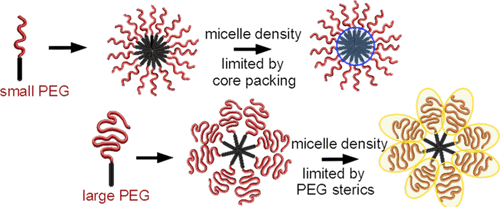当前位置:
X-MOL 学术
›
J. Phys. Chem. B
›
论文详情
Our official English website, www.x-mol.net, welcomes your
feedback! (Note: you will need to create a separate account there.)
Simulations Study of Single-Component and Mixed n-Alkyl-PEG Micelles.
The Journal of Physical Chemistry B ( IF 2.8 ) Pub Date : 2018-05-01 , DOI: 10.1021/acs.jpcb.8b00398 Maisa Vuorte 1 , Jukka Määttä 1 , Maria Sammalkorpi 1
The Journal of Physical Chemistry B ( IF 2.8 ) Pub Date : 2018-05-01 , DOI: 10.1021/acs.jpcb.8b00398 Maisa Vuorte 1 , Jukka Määttä 1 , Maria Sammalkorpi 1
Affiliation

|
Here, we study one-component and mixed n-alkyl-poly(ethylene glycol) (C mE n) micelles with varying poly(ethylene glycol) (PEG) chain lengths n using coarse-grained molecular simulations. These nonionic alkyl-PEG surfactants and their aggregates are widely used in bio and chemical technology. As expected, the simulations show that increasing the PEG chain length decreases the alkyl-PEG micelle core diameter and the aggregation number but also enhances PEG chain penetration to the core region and spreads the micelle corona. Both the core and corona density are heavily dependent on the PEG chain length and decrease with increasing PEG length. Furthermore, we find that the alkyl-PEG surfactants exhibit two distinct micellization modes: surfactants with short PEG chains as their hydrophilic heads aggregate with the PEG heads relatively extended. Their aggregation number and the PEG corona density are dictated by the core carbon density. For longer PEG chains, the PEG sterics, that is, the volume occupied by the PEG head group, becomes the critical factor limiting the aggregation. Finally, simulations of binary mixtures of alkyl-PEGs of two different PEG chain lengths show that even in the absence of core-freezing, the surfactants prefer the aggregate size of their single-component solutions with the segregation propelled via enthalpic contributions. The findings, especially as they provide a handle on the density and the density profile of the aggregates, raise attention to effective packing shape as a design factor of micellar systems, for example, drug transport, solubilization, or partitioning.
中文翻译:

单组分和混合正烷基-PEG 胶束的模拟研究。
在这里,我们使用粗粒度分子模拟研究具有不同聚乙二醇(PEG)链长度 n 的单组分和混合正烷基聚乙二醇(C mE n)胶束。这些非离子烷基-PEG表面活性剂及其聚集体广泛应用于生物和化学技术。正如预期的那样,模拟表明,增加 PEG 链长度会降低烷基 PEG 胶束核心直径和聚集数量,但也会增强 PEG 链对核心区域的渗透并扩展胶束冠。核密度和冠密度都严重依赖于 PEG 链长度,并随着 PEG 长度的增加而降低。此外,我们发现烷基-PEG表面活性剂表现出两种不同的胶束化模式:具有短PEG链的表面活性剂,因为它们的亲水头与相对延伸的PEG头聚集。它们的聚集数和 PEG 电晕密度由核心碳密度决定。对于较长的 PEG 链,PEG 空间,即 PEG 头基所占据的体积,成为限制聚集的关键因素。最后,对两种不同 PEG 链长的烷基 PEG 的二元混合物的模拟表明,即使在没有核心冻结的情况下,表面活性剂也更喜欢其单组分溶液的聚集体尺寸,并通过焓贡献推动分离。这些发现,特别是当它们提供了对聚集体的密度和密度分布的处理时,引起了人们对有效堆积形状作为胶束系统设计因素的关注,例如药物运输、溶解或分配。
更新日期:2018-04-17
中文翻译:

单组分和混合正烷基-PEG 胶束的模拟研究。
在这里,我们使用粗粒度分子模拟研究具有不同聚乙二醇(PEG)链长度 n 的单组分和混合正烷基聚乙二醇(C mE n)胶束。这些非离子烷基-PEG表面活性剂及其聚集体广泛应用于生物和化学技术。正如预期的那样,模拟表明,增加 PEG 链长度会降低烷基 PEG 胶束核心直径和聚集数量,但也会增强 PEG 链对核心区域的渗透并扩展胶束冠。核密度和冠密度都严重依赖于 PEG 链长度,并随着 PEG 长度的增加而降低。此外,我们发现烷基-PEG表面活性剂表现出两种不同的胶束化模式:具有短PEG链的表面活性剂,因为它们的亲水头与相对延伸的PEG头聚集。它们的聚集数和 PEG 电晕密度由核心碳密度决定。对于较长的 PEG 链,PEG 空间,即 PEG 头基所占据的体积,成为限制聚集的关键因素。最后,对两种不同 PEG 链长的烷基 PEG 的二元混合物的模拟表明,即使在没有核心冻结的情况下,表面活性剂也更喜欢其单组分溶液的聚集体尺寸,并通过焓贡献推动分离。这些发现,特别是当它们提供了对聚集体的密度和密度分布的处理时,引起了人们对有效堆积形状作为胶束系统设计因素的关注,例如药物运输、溶解或分配。











































 京公网安备 11010802027423号
京公网安备 11010802027423号